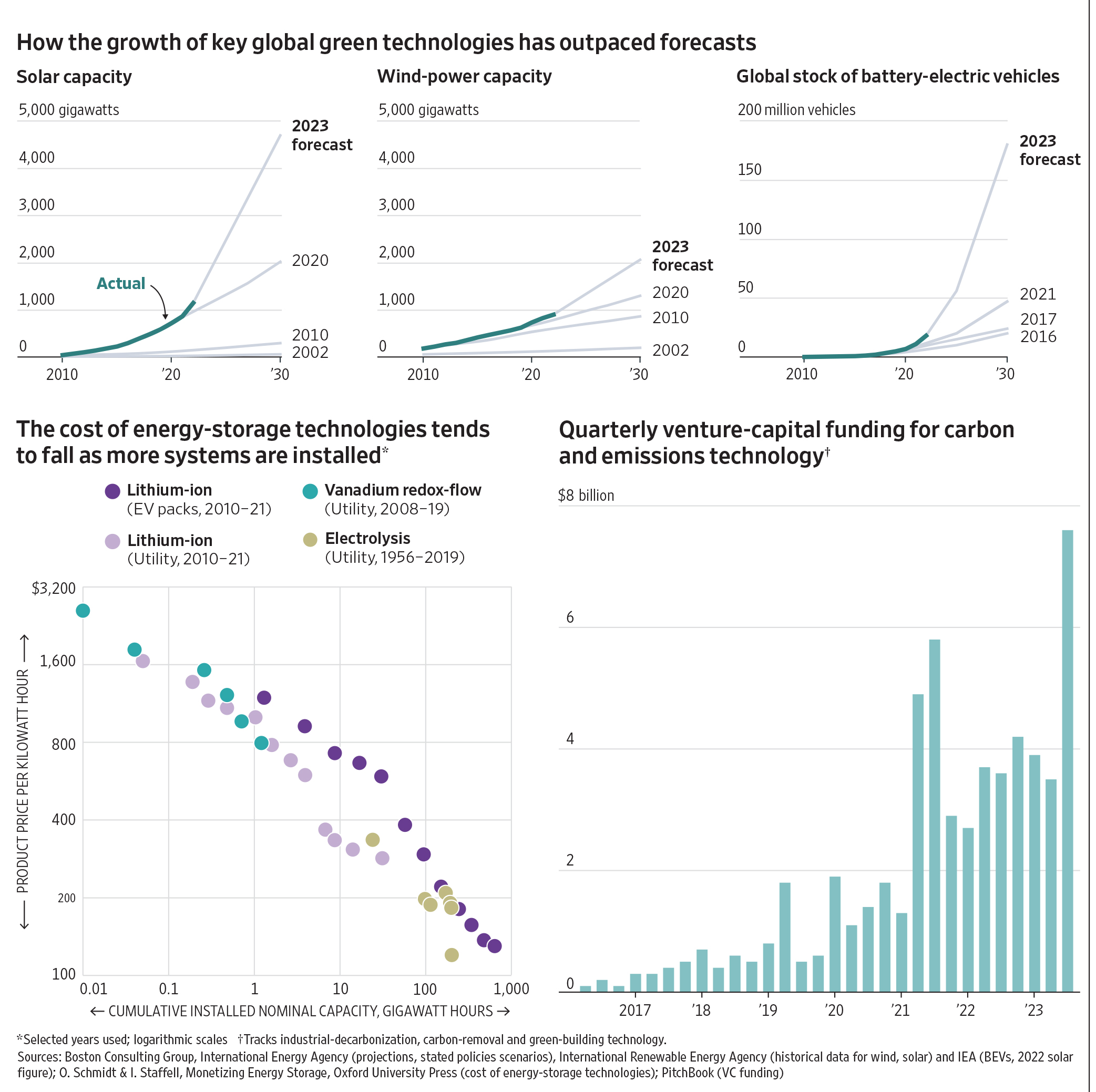Costs plummet, offering hope for reducing use of fossil fuels
There is no shortage of bad
green-energy news. Automakers are fretting about electricvehicle growth, higher interest
rates are smashing financial
plans, permitting for big projects still takes forever and offshore wind is a mess.
But for every setback, there
is a Sun Streams. This cluster
of solar farms will cover more
than 13 square miles of desert
west of Phoenix. By 2025, it
will provide enough electricity
for roughly 300,000 homes,
bringing Arizona’s largest utility closer to its goal of a zerocarbon grid.
The scale of the development, mostly owned by renewables company Longroad Energy, is part of a staggering
surge in renewable energy.
Driven by falling costs and
better technology, growth in
renewables has consistently
exceeded expectations.
The annual United Nations
climate summit starts later
this week in Dubai. What has
become clear after years of
talking is that few countries,
businesses or people are willing to sacrifice much to limit
climate change. The explosion
of clean energy offers hope for
cutting fossil-fuel use.
“We are coming short on
many dimensions, and we
have an enormous amount of
work to do,” said Rich Lesser,
global chair of Boston Consulting Group. “But, equally important, our ability to make
progress on the technology
side has dramatically exceeded
our expectations.”
In 2009, the International
Energy Agency predicted that
solar power would remain too
expensive to compete on the grid. It continued to underestimate the growth of renewable energy and EVs. Last
year, more than four-fifths of
the world’s new power capacity was renewables, according
to the International Renewable
Energy Agency.
Subsidies drove early
growth in wind and solar, then
technology refinements and
large-scale manufacturing
made them cheap. Lithium-ion
batteries, which power cars
and store electricity on the
grid, plunged in price, too. Sun
Streams will have enough batteries to power about 40,000
Teslas.
Money is continuing to flow
into these projects despite
green energy’s headwinds.
Longroad, the developer, said
it raised $600 million of debt
finance to expand its portfolio
in a deal led by Apterra Infrastructure Capital, an affiliate
of Apollo Global Management.
Research firm Rystad Energy estimates that we are on
course to burn enough oil, gas
and coal to heat the planet by
between 1.6 degrees and 1.9
degrees Celsius above prein dustrial levels, depending on
how urgently governments act
to speed up the transition.
That is rosier than many
other forecasts, though it exceeds the international target
of 1.5 degrees that is seen as a
comparatively safe limit.
Rystad’s bullishness comes
from the sun. Chief Executive
Jarand Rystad said the spread
of solar panels is compensating for lagging sectors such as
offshore wind, which has been
hobbled by cost overruns and
snarled supply chains.
BloombergNEF expects solar
panels installed this year to
add nearly 400 gigawatts of
generating capacity. That is 4.5% of the generating capacity
of the world’s power plants in
2022. On the current trajectory,
transition bulls argue, it is a
matter of when renewables
erode fossil-fuel use, not if.
The IEA expects demand
for coal, gas and oil to peak
this decade. Many fossil-fuelproducing companies and
countries are betting on a long
future for their products, and
peak-oil talk has been wrong
before.
But it is also easy to underestimate the pace of change.
Projections by the U.S. Energy
Information Administration
didn’t see how quickly renewable energy and natural gas
would erode U.S. coal consumption.
Much depends on China,
where the growth of wind and
solar coincides with new coal
projects. Optimists say coal
plants will act as backup in a
system increasingly dominated
by renewables. China leads the
world in long-duration battery
projects, according to
BloombergNEF.
Jarand Rystad said fossilfuel power generation in China
is close to a peak. “The tipping
point is very soon,” he said.
The average cost of solar
power fell nearly 90% between
2009 and 2023, with onshore
wind declining by two-thirds,
according to BloombergNEF.
Similar declines are starting to reshape transportation.
EV costs are falling, and infrastructure is improving. The total cost of ownership of small
and midsize EVs is cheaper
than gasoline-powered vehicles in China and Europe and
could hit that point in the U.S.
next year, according to the
Economics of Energy Innovation and System Transition
project led by the University
of Exeter.
In this view, renewables,
batteries and EVs will become
more popular as they get
cheaper and better. Emerging
green-energy technologies
such as hydrogen, which is
benefiting from government
support and a surge in private
investment, could follow the
same path.
Investors including Singapore state investment company Temasek put up €1.5 billion, or about $1.64 billion, for
a low-carbon steel plant in
Sweden in September as more
money flows into decarbonizing industrial processes.
Thorny emissions problems
now have competing possible
solutions. Startup Boston
Metal recently raised $262
million to make green steel via
a method that uses electricity
rather than hydrogen. Two
others, Rondo Energy and Antora Energy, are manufacturing thermal batteries that
store electricity as heat—a
way to power high-temperature processes while using up
surplus renewable power.
“The fact that solar and
wind costs have come down so
dramatically has opened up a
whole new set of options,”
said Dolf Gielen, an energy
economist at the World Bank.
